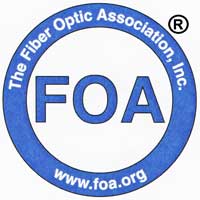

August
2020
|
Search the FOA website
FOA
Home Page Contact
Us
|
Sign
up for the FOA eMail Newsletter
Privacy
Policy
Sections
News
Technical Worth
Reading Q&A
Training/FiberU
Resoures
Safety
About
|
- In
This Issue
- Note
we have changed the format to place articles in
sections on one topic and all articles are dated so
you know if we repeat one - whcih we often do when
we think it's very important!
FOA
Turns 25.
Projects For Teachers, Kids and Parents.
Winter Installations.
Mystery Connectors.
The Cost of Connectivity.
Replacing A Utility
Pole.
Newsletter
Sections
Click
on any link to jump to that section
News
Training Adapting To Pandemic, Google Fiber is back,
Verizon to retire copper, aerial install messes
Technical
Total internal reflection , the mystery of
loss in dB solved, splices on OPGW, manufacturers of
prepolished connectors, more
Worth
Reading Connectivity is a necessity,
NYTimes, more
Q&A
As usual, new questions
Training/FiberU
Making training classroom safe, onine training,
materials, more
Resoures
Safety
About
FOA Certifications:
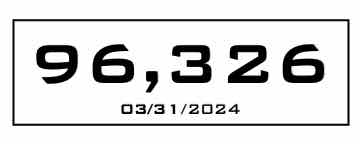
Time
To Renew Your FOA Certifications?
Special
offer - 1/3 Off Renewal
Jobs
- See
FOA Jobs
Web Page and FOA on

- The
FOA Jobs
Web Page has been updated and a new page added on Using
your FOA Training/Certification to Find the Right Job
in Fiber Optics
Where
Are The Jobs In Fiber Optics? FOA talks about all the
applications for fiber optics, what jobs involve and the
qualifications for the workers in the field in this YouTube
video.
Join
The FOA eMail Newsletter List
Want to
be notified when the FOA Newsletter is updated? Sign
up for the FOA eMail Newsletter. You can also
sign up from your cell phone: text "FOA" to 22828 (usual
text message charges apply)
Trademarks:
The FOA CFOT® (Certified Fiber Optic Technician) and
Fiber U® (the FOA online self-study program) are registered
trademarks of the FOA.
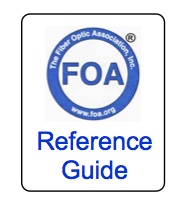
Want
to know more about fiber optics? Study
for FOA certifications? Free
Self-Study Programs are on "Fiber
U®." Looking for specific information? Here's the
largest technical reference on the web: The
FOA Online Fiber Optic Reference Guide.
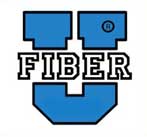
Free
online self-study programs on many fiber optics and cabling
topics are available at Fiber
U, FOA's online web-based training website.
FOA
Reference Books
Available Printed or eBooks
The
fiber book is available in Spanish and French
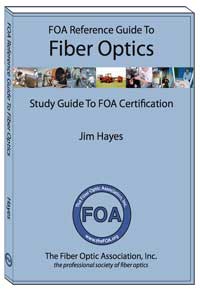
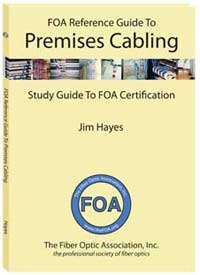
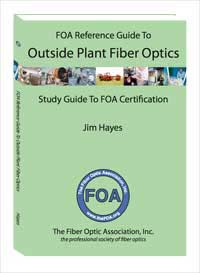
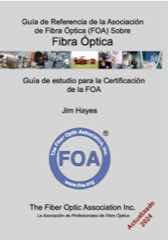
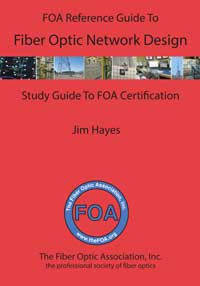
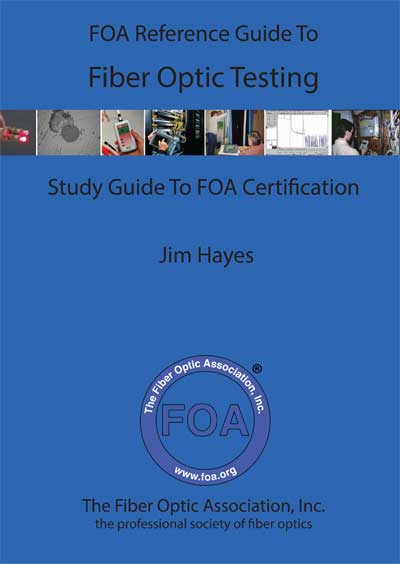
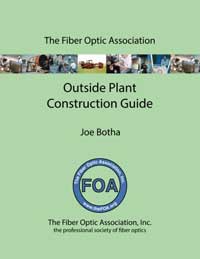
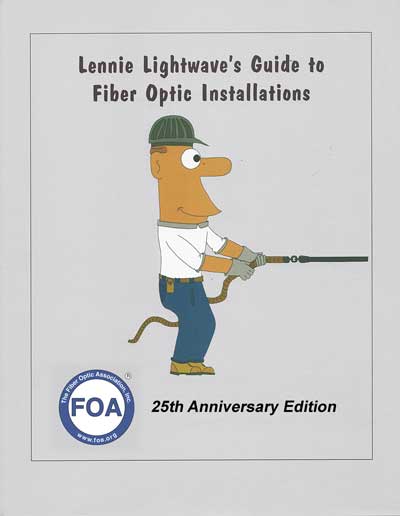
Lennie
and Uncle
Ted's Guides are now also available as free iBooks on
iTunes.
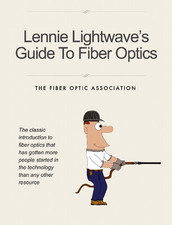
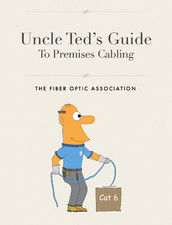
Click
on any of the books to learn more.
- Fiber
Optic Safety Poster to download and print
FOA
Videos on 
FOA
is a member of:




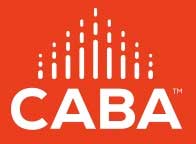
The
FOA Newsletter is edited by Jim Hayes - send your stories,
leads, ideas, comments to <jim @ foa.org>

Search
the FOA Website With DuckDuckGo
- The
Archives: Past Issues.
- Use
these links to read past issues or use FOA's
Custom Search to look for specific topics on our
website.
1/20,
2/20, 3/20.
4/20, 5/20,
6/20, 7/20,
8/20,
1/19,
2/19, 3/19,
4/19,
5/19, 6/19,
7/19, 8/19,
9/19, 10/19,
11/19,
12/19
1/18,
2/18, 3/18,
4/18, 5/18, 6/18,
7/18, 8/18,
9/18, 10/18,
12/18.
1/17,
2/17, 3/17,
4/17, 5/17,
6/17, 7/17,
8/17, 9/17,
10/17, 11/17,
12/17
1/16,
2/16, 3/16,
4/16,
5/16, 6/16,
7-8/16, 9/16,
10/16, 11/16,
12/16
1/15,
2/15, 3/15,
4/15, 5/15,
6/15, 7/15,
8/15, 9/15
, 10/15,
11/15 , 12/15
1/14,
2/14, 3/14,
4/14, 5/14,
6/14, 7/14,
8/14, 9/14,
10/14, 11/14,
12/14
1/13,
2/13, 3/13,
4/13, 5/13,
6/13, 7/13,
8/13, 9/13,
10/13, 11/13,
12/13
1/12
, 2/12, 3/12,
4/12, 6/12,
7/12, 8/12,
9/12, 10/12,
11/12, 12/12
1/11
, 2/11,
3/11,
4/11,
6/11, 7/11,
8/11, 9/11,
10/11, 11/11,
12/11,
1/10
, 2/10,
3/10, 4/10,
05/10,
07/10,
08/10, 09/10,
10/10,
11/10
1/09
, 2/09,
3/09, 04/09,
05/09,
07/09,
08/09, 09/09,
10/09, 11/09,
12/09
1/08
, 2/08, 3/08,
4/08, 5/08,
6/08, 7/08,
8/08, 09/08, 10/08,
11/08, 12/08
12/07 , 11/07,
10/07, 09/07,
08/07, 07/07,
06/07, 05/07,
04/07, 03/07,
2/07, 1/07
12/06
, 11/06, 10/06,
09/06, 8/06,
7/06, 6/06,
5/06, 4/06,
3/06, 2/06,
1/06,
12/05
,11/05, 10/05,
09/05, 08/05,
07/05, 6/05,
5/05, 4/05,
2/05, 01/05,
12/04
, 10/04, 9/04,
8/04, 7/04,
6/04, 5/04,
4/04, 3/04,
1/04,
12/03
, 11/03 10/03
9/03, 8/03,
7/03, 6/03,
3/03, 10/02
, 8/02, 5/02
Current Issue of FOA Newsletter
Time
To Renew Your FOA Certifications?
To keep
your FOA certifications active, you need to renew them when
they expire. Now we have a new more convenient way to renew
- an online store at Paypal - where you can quickly and
conveniently use your PayPal account or your credit card to
renew your certifications.
- You
can now renew with PayPal or a credit card
-
PayPal
is available worldwide
Join
FOA On Social Media

FOA has
four LinkedIn Groups
FOA
- official page on LinkedIn
FOA
- covers FOA, technology and jobs in the fiber optic
marketplace
FOA
Fiber Optic Training - open to all, covers fiber optic
technology and training topics
Grupo
de La Asociación de Fibra Óptica FOA (Español)
SPECIAL
OFFER - Save 1/3 On Your Certification Renewal Cost
In the
near future, there will be a requirement for continuing
education to renew your FOA certifications. FOA is testing
an option for renewals where you take a short Fiber U online
course.
If you would like to help FOA test this option, you can save
1/3 the cost of your renewal. Go
here to take the Fiber U CFOT Renewal Course: |
FOA
Newsletter - Features
1995-2020
- FOA's 25th Anniversary!
As part
of celebrating 25 years of serving the fiber optic industry
as its primary source of technical information and
independent certifying body, FOA thought it appropriate to
create a short history of the organization and how it has
developed to help the fiber optic industry. We also
wanted to recognize the contributions many people have made
to the organization over the years that made FOA what it is
today.
The FOA history is now archived on the FOA website where
you can read it anytime or link to it.
Updated
info - dB, total internal reflection and science projects,
Updated
And Expanded Fiber Optic Projects For STEM Teachers, Kids
and Parents
Many
people are now working from home or are attending online
classes for their schools. Many parents are also helping
their children with their schoolwork as well as doing their
own work. We've heard from parents and teachers who are
looking for projects that will keep their kids interested as
well as help them learn.
FOA has always had free
esources for STEM teachers in the K-12 range as
well as our certification curriculum for technical colleges
and professional training. The current need for more online
information for students has led us to make some major
changes recently to our support programs for teachers.
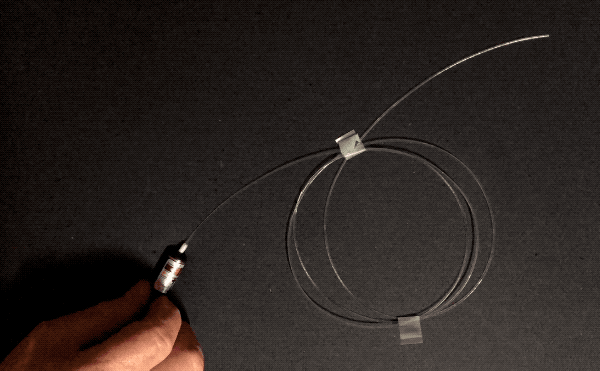
Several of our
fiber optic classroom projects use plastic
optical fiber (POF) like this one, which uses a regular
laser pointer and a sample of POF available from FOA to show
how fiber optics communicates using pulses of light.
To add to the technical aspects of fiber optics and help
teachers create lesson plans that include more theory,
including math, we've added sections on the speed of light
(how long does a pulse take to go from New York to London?),
wavelengths of light, total internal reflection and even
wavelength division multiplexing.
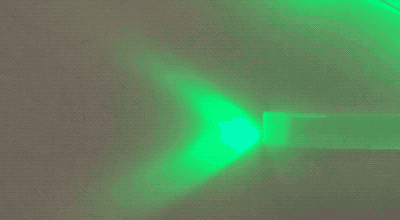
While many of the projects we suggest for teachers are good
for grades K-12, these new projects are mainly aimed at
Grades 7-12 and some even require math like trig.
As always, FOA is glad to support teachers. They can contact
us for samples of POF and a kit to help them use it for
class projects. FOA also provides videos just for classroom
use. We are also ready to help students with their science
projects.
If you have kids at home, these projects may be perfect for
parent/student projects and/or recommending to your kids
teachers.
Fiber
Optic Resources For STEM Teachers.
Time
To Talk About Winter Installations
We
know it's midsummer, but a FOA newsletter reader inquired
about a plan for installation of fiber optic cable in a far
North region. The area involved was around the Arctic Circle
in Canada, so we called upon FOA Director Bill Graham from
Canada who has extensive experience training in the cold
regions. He often sends us photos of his travels to the
North. Doesn't this look cold?
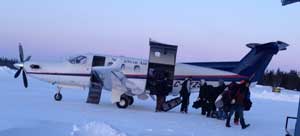
Bill
responded to the installer's inquiry with an extensive set
of advice and instructions for installation in very cold
climates. We thought these were particularly useful and
should be shared. Many of these are not specific to fiber
optic installations but simply cold weather survival. The
focus is mostly on aerial cable as installing cable in
frozen terrain can be very difficult.
Hints For Installing cable in cold weather:
Safety
overall is the biggest concern with your cold environment
and additional risk due to mechanical failures is a factor
to contend with in your situation. Make sure your crews are
safety trained and ready for any contingency.
Some
guys used chemical heating pads in their glove bases and
have the best thermal gear affordable.
Additional
equipment such as line trucks, winches, etc. should be part
of your plan. Bring
lots of additional mechanical capacity to pull out stuck
vehicles, etc. with chains and tow straps. Make
sure you use lubricants that will not freeze up. Always
have several extra torches.
Keep the block heater in your diesel engine cycled on the
generator using a timer so it occasionally keeps the
engine heated up. The biggest failure factor in winter is
bad fuel or fuel gel. Fuel system maintenance and fuel
additives need a lot of attention. Know your fuel sources
all it takes is one bad tank to ruin your day. Keep a couple
of metal trash can lids and some bag charcoal that you can
light, and slide the hot ashes under an axle to thaw brakes
or lines when necessary.
More manpower greatly decreases risk. Invest in high quality
headset radios. Backup
radio systems and a good buddy system for crews is also
important. Also, plenty of battery lights.
Preheat
cables on the spool prior to pulling. The stiffness of OSP
cable at extreme cold temperature is a real problem . Use
preheated trailers during the aerial pulling process because
it just became too stiff for working bends and expansion
loops. Just an enclosed trailer with propane heat source
(very basic) will help you out. Sometimes you might set up
tents. Pay
strict attention to the aerial lasher mechanisms and cable
rollers and keep them in a heated environment when not in
use.
Hopefully you are splicing in a heated trailer!! I can’t
imagine making an osp splice in winter up there in that cold
country without lots of heat for you and the equipment.
Plenty of propane with lots of reserve for every crew.
Placing
aerial anchors and down guys in the frozen soil (or tundra)
is tough and always used a punjar (drill) to make sure
the anchors were set deep and were tension tested before
transferring the anchor load.
In that cold environment it would be a good plan to place
additional expansion loops at poles due to longer spans with
plenty of contraction. Spans that are longer have more
clearance issues with trees and terrain.
Paying strict attention to pole condition is critical. If
you are hooking poles then you may have to deice a few for
safety. Wood rot is accelerated in extreme climates.
Thaw the ground under your outriggers and spiked in
wheel chocks because there is no feeling like having a truck
slide down the hill with you in the bucket.
Stay warm!
Mystery
Connectors No Mystery At All
Twice
in the last month, FOA received calls from puzzled
contractors wondering what a type of connector was the ones
they were being asked to repair. Coincidentally, both were
working on wind farms where fiber optic cables were used up
the towers of the windmills. One described it as having a
screw-on nut like an FC but the ferrule was too large to fit
in a 2.5mm ferrule adapter. Another installer sent us this
photo:
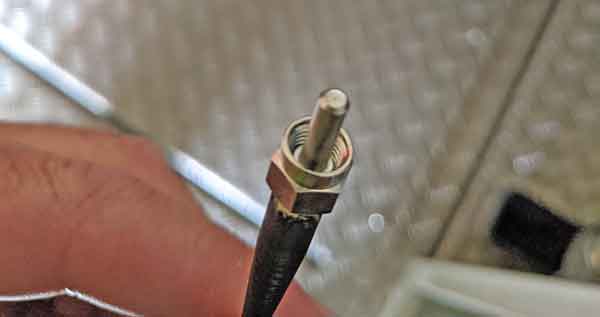
Do you recognize this connector? It's a SMA, a fiber optic
connector design from 40+ years ago developed by Amphenol
and still in production and use. The SMA name comes from the
nut, the same as a microwave connector called "Sub-Miniature
A," a coax connector developed in the 1960s and perhaps the
most widely used microwave connector.
SMA's are one of the oldest connector designs and are still
widely used in military, high reliability and high power
applications, The all metal design is really reliable and
handles high power easily since the design is all metal and
can withstand high temperatures. It is still used in many
process control applications where a rugged all-metal
connector is preferred, like in the equipment used with wind
power generation controllers.
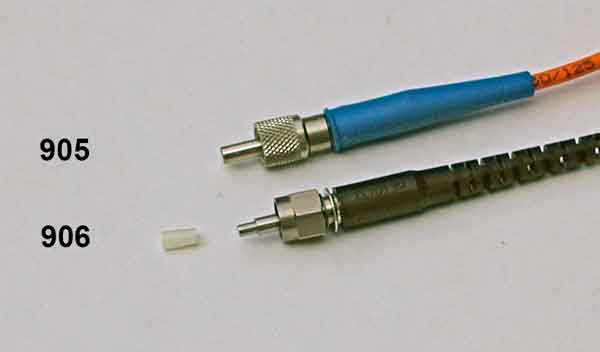
Two styles of SMA ferrules were available, SMA 905 with a
straight ferrule and SMA 906 with a smaller diameter at the
end that used nylon alignment bushings to get more precise
alignment. The
SMA 905 fiber ferrule is 1/8 inch diameter (specified in
English units - 0.125 inches
but
~3mm)
and the 906 ferrule has a smaller 0.085 inch (~2mm) tip to
fit the nylon alignment bushing.
The SMA ferrule was originally a metal machined part,
drilled for the fiber size being terminated.
SMA
connectors were available for lots of fiber sizes, since the
holes in the ferrules were drilled. Holes
up to 2mm for plastic fiber are possible. One
of the cables in a wind farm used 200-240 PCS fiber -
plastic clad silica step-index fiber. Stainless steel and
aluminum were mainly used for SMA ferrules but now you can
get ceramic or plastic ferrules.
The SMA locking nut has a small 1/4-36 UNS thread. Nuts with
hex or knurled forms have been available and hex versions
are available drilled for safety wires for use in high
vibration environments like military platforms (aircraft,
helicopters, ships.) Military connectors also have available
a special torque wrench to tighten the SMA nut precisely.
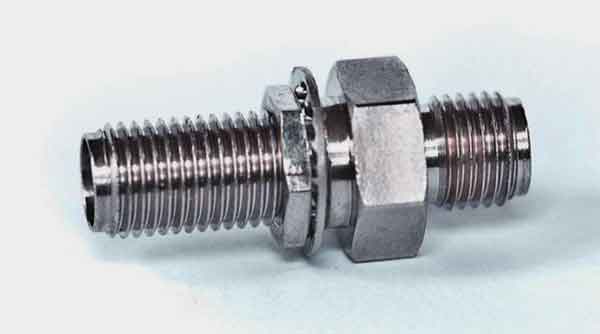
The SMA design is not a keyed connector, so the ferrules can
rotate in a mating adapter , shown above. As a result, the
ferrule length must be tightly controlled to prevent the two
mated ferrules from touching, rotating against each other
and scuffing the fibers. As a result, the SMA is an "air
gap" connector with resulting higher loss and reflectance
than ceramic ferrule PC (physical contact) connectors. The
SMA therefore is not considered an acceptable connector for
most singlemode applications.
SMA connectors were originally used with epoxy/polish
terminations, but crimp/polish, crimp/cleave and a unique
swaged termination have been offered. The swaged version in
quite unique. A tool
impact impacts the ferrule around the fiber and swages the
fiber in place, ready for polishing. From our experience, it
works quite well.
Strangely enough, for a connector with such history and
longevity, there has never been a TIA standard FOCIS
document (Fiber Optic Connector Intermateability Standard)
for it.
You
can find photos and descriptions of many fiber optic
connector types on the FOA Guide page "Connector
Identifier."
The
importance of Internet connectivity worldwide has never
been greater than now, with business depending on online
meetings and conferences in addition to the usual
communications, schools learning how to use online
learning and applications like citizen participation in
government and telehealth actually becoming commonplace.
That makes this report even more important.
The
Cost of Connectivity 2020 (Worldwide)
This
report
just published by the Open Technology Institute looks
at the cost of Internet service around the world. The report
is an eye-opener, especially for Americans. When it comes to
Internet service, America has the most expensive service in
the world, like our healthcare, and like healthcare, we have
among the worst service. The report blames "the collective
prevalence of monopolies and oligopolies," "where ISPs
(internet service providers) face little to no competition,
consumers are the ones who suffer—they’re forced to pay
higher prices, penalties for exceeding data caps, and, if
they’re lucky enough to have more than one option for
internet service, high switching costs."
We will quote the executive summary here but suggest you
read the whole report.
Executive Summary
In this year’s Cost of Connectivity report, we find further
evidence that people can expect to pay more for internet
service in the United States than in Asia or Europe. Our
previous studies—published in 2012, 2013, and
2014—consistently showed that U.S. consumers paid higher
costs for slower speeds than consumers abroad. Some of these
trends continue in the 2020 report. Our research has
additional urgency this year, as many people rely on the
internet to navigate new realities presented by the COVID-19
pandemic. This year’s report is also our most extensive to
date, examining 760 plans in 28 cities across Asia, Europe,
and North America, with an emphasis on the United States. In
our dataset, 296 plans are located in the United States and
462 plans abroad.
- Across
North America, Europe, and Asia, we find the highest
average monthly prices in the United States. Fiber plans
are the most expensive option in all three markets, with
the United States being the most expensive.
- We
find substantial evidence of an affordability crisis in
the United States. Based on our dataset, the most
affordable average monthly prices are in Asian and
European cities.
- Consumers
must navigate a maze of additional fees and hidden costs
to determine the total price of internet service. These
ancillary fees create complicated pricing structures
that make it difficult for consumers to compare plans
and understand the total price they can expect to pay.
- Municipal
networks appear to offer some of the best value in the
United States. A growing body of evidence indicates that
these locally-owned networks yield significant cost
savings for consumers, yet at least 20 states restrict
or outright prohibit these networks from existing.
- The
U.S. market suffers from a lack of competition. This
lack of choice directly affects the cost and quality of
internet service.
- ISPs
are not transparent with consumers, the government, or
researchers. ISPs do not disclose accurate data
about their networks, so it is difficult for researchers
to determine where service is even available.
Read
the entire report here.
How
Many Cranes/Bucket Trucks Does It Take To Replace A
Utility Pole?
Note -
you can click on any photo to see a much larger version
for more details. Use the back arrow to return to the FOA
Newsletter.
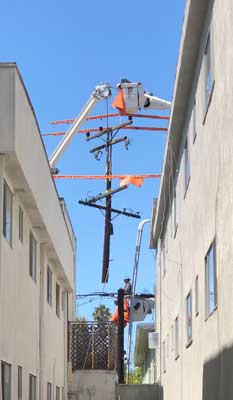
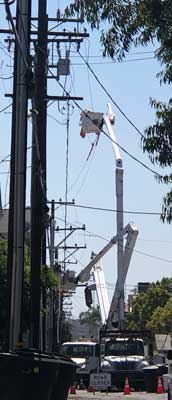
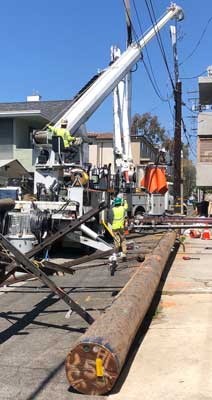
Note
- you can click on any photo to see a much larger
version for more details. Use
the back arrow to return to the FOA Newsletter.
We've published a lot of photos in
this Newsletter from the work we've seen being done here in
Santa Monica, but last week had some really interesting work
being done in the alleys. Workers from Southern California
Edison were replacing old wooden utility poles with new,
bigger ones.
We first discovered this by hearing noise and seeing the top
of a pole being lifted by a crane, shown in the photo on the
left above, viewed between two apartment buildings looking
toward the alley. Needless to say, the alley was blocked off
so we circled the block to get a better view. From one end
of the alley, we could see 3 booms. The one in the center
was a bucket but with brackets to grab the high voltage
lines on top of the pole and support them while the pole was
replaced. The wires can be seen by the orange insulation
around the wires to protect the workers - they did not
turn the HV off !(~14KV)
In the photo on the right, you can see the new pole waiting
for installation with all the hardware already installed.
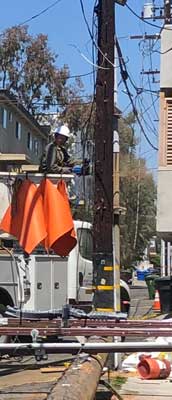
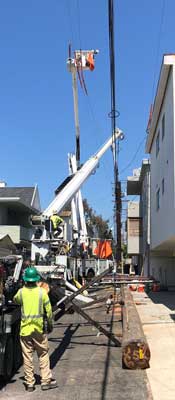
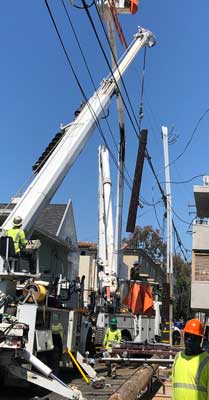
Note
- you can click on any photo to see a much larger
version for more details. Use
the back arrow to return to the FOA Newsletter.
Here on the left you can see the worker using a chain saw to
cut the next section of the pole off. All the hardware has
been disconnected from the pole and a crane is holding it
from the top ready to haul it away. In the middle photo you
can see the three booms - the top one suspending the high
voltage wires, the middle one supporting the next section of
the pole being cut off and the third one folted to get the
worker with the chain saw near the pole. This was a very
crowded alley!
The photo on the right shows the really delicate part of the
operation - removing the middle section of the pole. The
crane has to avoid the HV lines and the bucket supporting
them, the numerous low voltage (copper and fiber) cables in
the telecom space, the buildings and the trucks and workers.
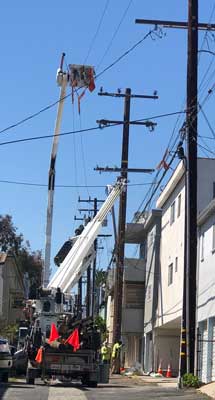
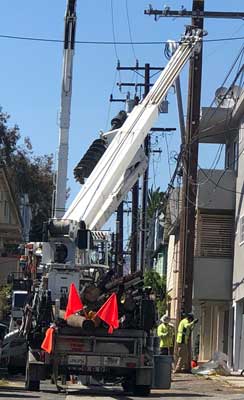
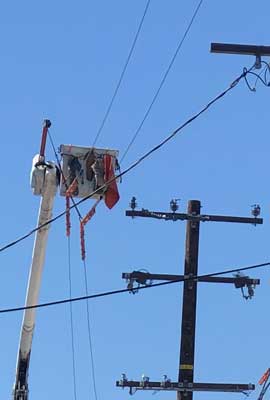
Note
- you can click on any photo to see a much larger
version for more details. Use
the back arrow to return to the FOA Newsletter.
After all the sections of the old pole are removed, the new
pole is set into the ground - quite a delicate operation -
and all the hardware - including a transformer - reattached.
The entire process takes about 6-8 hours. While this one was
done in daylight, they replaced a pole in the alley behind
us in the middle of the night!
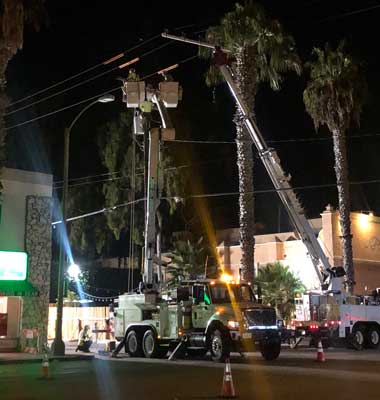
Note
- you can click on any photo to see a much larger
version for more details. Use
the back arrow to return to the FOA Newsletter.
FOA
Newsletter Sections
News
Technical Worth
Reading Q&A
Training/FiberU
Resoures
Safety
About
|
News
|
Classroom
Training Is Adapting To The Pandemic 8/2020
FOA
Director and instructor Tom Collins sent photos of his
recent IMSA/FOA CFOT class held in Florida. It shows how Tom
dresses for the job and how his students are social
distancing. More FOA classes are being held now using
techniques like these.
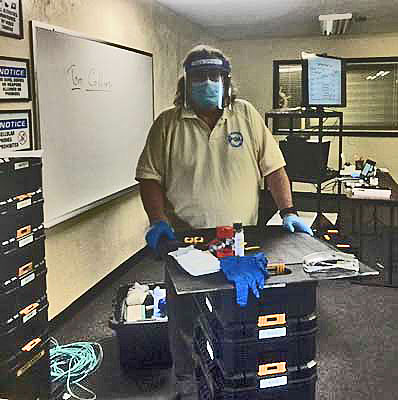
Instructor Tom Collins perpared to teach in the classroom.
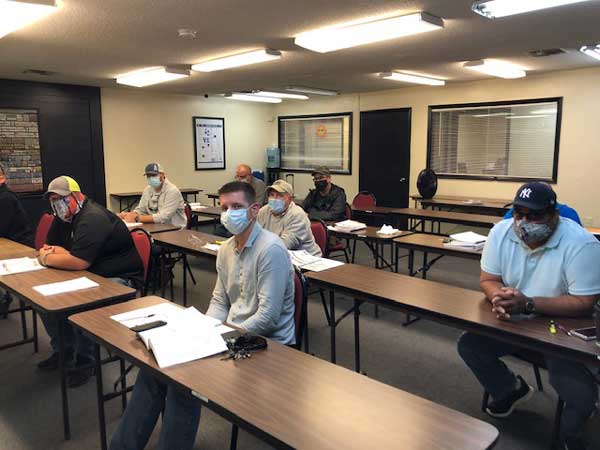
Students with appropriate distancing.
See more classroom setups.
Utopia
Fiber Creates Wildfire Monitor System in Rural Utah 8/2020
The
EDWIN Project (Early Detection Wildfire Imaging Network) is
a UTOPIA Fiber initiative that monitors high-risk wildfire
areas utilizing fiber-connected thermal imaging cameras.
EDWIN is still in its developmental stages as we design
methods to analyze the live feeds of these cameras to detect
potential threats automatically. This project began as a BYU
capstone project in collaboration with UTOPIA Fiber and is
now managed by the UTOPIA Fiber Smart City team.
Thermal
imaging cameras have a unique ability to detect minute
temperature change and developing hotspots that could lead
firefighters to wildfires long before smoke is visible,
significantly cutting down on response time and potentially
saving lives and property. This project would not be
possible without fiber connectivity, which allows immense
amounts of data to move instantly and notify officials
automatically.
Read
more from the Utopia website.
What
Does This Mean?
Google
Fiber is Coming to Millcreek, UT 8/2020
"Provo
was one of the earliest Google Fiber cities — there, we
built great relationships grounded in the city’s vision to
connect an entire community to high-speed internet. That
experience led us north to Salt Lake City, where we’ve
been building, in the more traditional sense, a
from-scratch fiber network to deliver gigabit internet to
homes and businesses across Utah’s capital city."
"As
we finally near completion of construction in Salt Lake
City, we’re not ready to stop growing in Utah. So, we’re
excited to announce that we’ll continue to build our
network into the neighboring city of Millcreek."
From
the Google Fiber Blog
Google
Fiber To Expand - First New City In 4 years - 7/2020
Google
Fiber is in the news again, agreeing to become a user of
West Des Moines, Iowa's conduit system to install a FTTH
system. This will be the first system GF has announced in
4 years after some difficulties in other cities. There
should be fewer problems with installation here since
fiber ill be pulled in the conduits owned by the city but
not yet built. GF will cover part of the construction cost
and be the first tenant but others may use the conduits
also, paying the city a leasing fee. The city estimates it
will take 2.5 years to install all the conduits.
Read
more from the City
of West Des Moines.
You Knew This
Was Coming!
7/2020
Verizon wants
to retire copper facilities in parts of Virginia, Maryland
and New England
Verizon is asking the FCC for permission to retire
copper networks throughout its service territory in New
York, Massachusetts, Maryland, Virginia, Rhode Island and
Pennsylvania. Some of these filings can be found in this
FCC notice.
Verizon will no longer support copper in these exchanges and
will stop doing any maintenance on copper. The company
intends to move people who still are served by copper over
to fiber and is not waiting for the FCC notice period to
make such conversions.
Read
more on POTS and PANS
What
Were They Thinking? 7/2020
Aerial
messes on Pacific Coast Highway, Malibu, CA. July 2020. That
must be 2-300m of cable! They were only there a month but
really?
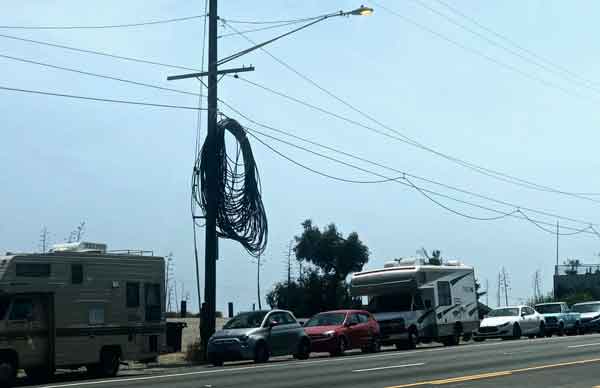
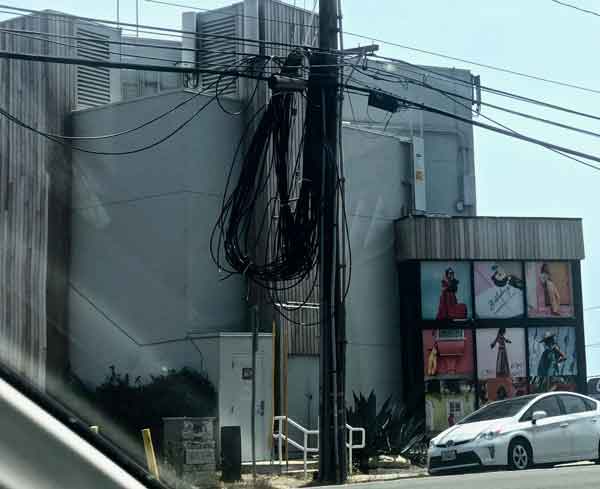
Recycling
Fiber Optic Cable - Contact:
Steve Maginnis
LD4Recycle/ CommuniCom Recycling
(Visit
website)
sm@LD4Recycle.com
803.371.5436 |
Technical
On
fiber optic technology, standards, equipment,
installation, etc.
The
FOA Update Page
covers all the new technology and applications we covered
in this newsletter recently. Now you can review all that
new tech at once.

Want
to know more about fiber optics? Study
for FOA certifications? Free
Self-Study Programs are on "Fiber
U®." Looking for specific information? Here's the
largest technical reference on the web: The
FOA Online Fiber Optic Reference Guide.
Try
The FOA's New Online Loss Budget Calculator
FOA has
written many articles about loss budgets, something everyone
involved in fiber optics needs to know and needs to know how
to calculate. We've created a online Loss Budget Calculator
that does the work for you. Just input your cable plant data
and it calculates the loss budget. It works on any device,
especially smartphones and tablets for field use and even
allows printing the results.
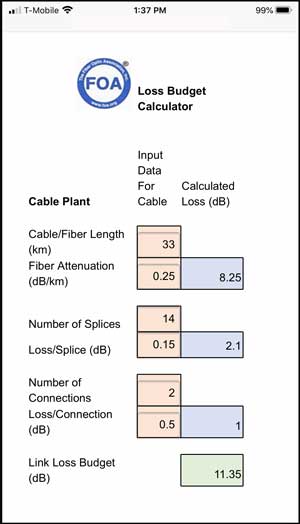
Bookmark
this page (especially on your smartphone: FOA
Loss Budget Calculator Online
|
How
Fiber Works - Total Internal Reflection - For Math
Lovers 8/2020
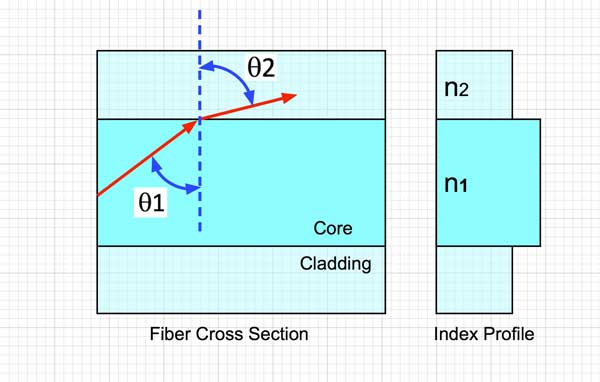
FOA has always had information on how fiber works using
total internal reflection, but we've recently updated our
web page on the subject to include a more complete
explanation using Snell's Law and the math that allows you
to calculate the parameters of the fiber including NA -
numerical Aperture.

FOA
Guide page on Total Internal Reflection
dB
or not dB, that is the question (8/2020)
FOA
has spent considerable space in this newsletter discussing
the confusion of dB measurements. FOA received a comment
from a very technical person we know who used to work for a
major fiber optic instrument manufacturer. He tries to
explain the issue thusly:
"I
submit that optical LOSS can be positive or
negative. I submit that optical GAIN can be positive
or negative. I submit that the CHANGE in optical
power (note that you use the word “change” in a dB
question below) can be positive or negative.
A negative Optical Loss is a gain. A positive
optical loss is a loss. Hence, Optical Loss
can either be positive or negative."
Redefining
relative dB measurements to make them read positive is
simply ignoring the scientific community and producing
extreme confusion by making gain a negative number. There
is no problem making “loss” just “dB” with no sign, as
long as it’s known that it is represented by a negative dB
number. Likewise “gain” can have no sign as long as it
follows scientific and technical convention which makes it
a positive number.
We
have likened this to “profit” and “loss” in our
explanations. They use similar conventions. Does any
company talk about a negative profit? Of course not.
The
issue has always been the display of data on an OLTS
or OTDR. If instrument manufacturers had wanted to do
it right, instead of ignoring scientific convention
and changing the definition, they would have changed
displays to have no sign for loss or gain but for,
example, make gain readings flash, change color or
show “gain” on the display. There is a convention for
doing that in scientific instruments for readings that
are out of range or otherwise improper.
We
cannot accept under any circumstances that “gain” is a
negative number. Our scientific and technical
education revolts at that!
dBm
- Evidence 8/2020 -
Here is an example of a power meter measuring in dBm and
microwatts (a microwatt is 0.001 or 1/1000th of a
milliwatt.)
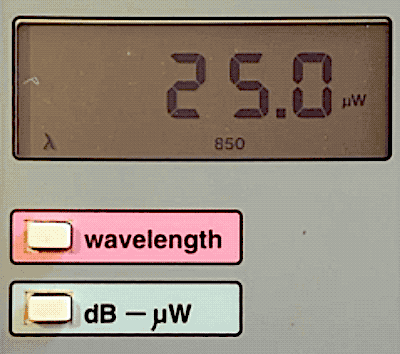
Here
is an example
of the
conversion of
watts to dBm.
This meter is
reading
25microwatts -
that's
0.025milliwatts.
If we convert
to dBm, it
becomes
-16.0dBm. We
can easily
figure this
out using dB
power ratios.
-10dBm is 1/10
of a milliwatt
or 0.100mW.
-6dB below
that is a
factor of 0.25
so 0.1mW X
0.25 = 0.025mW
or
25microwatts.
The other way
to figure it
is -10dB is
1/10 and -6dB
is 0.25 or
1/4th
(remember 3dB
= 1/2, so 6dB
= 3dB + 3dB =
1/2 X
1/2 = 1/4) so
-16dBm is
1/40milliwatt
or
0.025milliwatts
or
25microwatts.
Read a more
comprehensive explanation of dB here in the FOA
Guide.
dB
Update - Mystery Solved! 7/2020
Executive
Summary: IEC changed the definition of attenuation
to make it a positive number in defiance of mathematical
and metrological standards, centuries of mathematical
history and common sense.
To
Change The Negative Sign For Loss, Just Change The
Definition! Who Cares If Everybody Else Does It
Differently....
Just
recently FOA was reviewing a new proposed update for FOTP-78
IEC 60793-1-40 Optical Fibres - Part 1-40: Measurement
Methods and Test Procedures - Attenuation. This FOTP might
be the most-referenced FOTP since it deals with measuring
attenuation, something that dozens of FOTPs use in their
testing of components. I started reviewing this document by
skimming the Terms And Definitions, where I was stopped by
Section 3.1 which defined attenuation.
The classic attenuation equation was different.
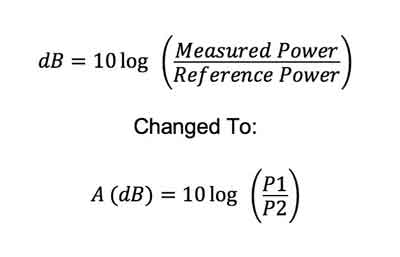
where (quoting from the standard)
- A
is the attenuation, in dB
- P1
is the optical power traversing cross-section 1 (e.g.
before the attenuation you are measuring - what we
would call the "0dB" reference in testing cables)
- P2
is the optical power traversing cross-section 2. (e.g.
after the attenuation you are measuring - what we
would call the measurement of loss in testing cables)
Note 1
to entry: Attenuation is a measure of the decreasing optical
power in a fibre at a given wavelength. It depends on the
nature and length of the fibre and is also affected by
measurement conditions.
As we traced this definition in other IEC standards, we find
they are variations of this, and one specifically states
that it expresses attenuation as a positive term.
So there you have it - why attenuation is positive - and
therefore gain - like a gainer on an OTDR - is a negative
number. The IEC standards just turned the measurement upside
down - reversing "Measured Power" and "Reference Power" to
get the term to become a positive number in dB when it's
attenuation.
And I might add, they are unique. See References
below. Undoubtedly some instrument manufacturer wanted the
definition that way and had no broad knowledge of
measurement convention. Nor did they understand fiber optic
power meters.
At least now we know where the confusion lies.
Three issues:
First:
There
are several reasons to object to this from a mathematical
and measurement standpoint. When you measure something
against a reference, it's common to divide the measured
value by the reference. Thus if something is getting
smaller, like attenuation, and the change is the measured
value decreases by 50% or half, you expect the ratio of
powers to be a number less than 1 because the value has
decreased, in this case the ration would be 1/2 or 0.5 0r
50%.
Consider what happens when using the equation above. If P1
is the reference and P2 the value after it decreases, the
ratio for the example above would be 2. Wouldn't anybody
assume that the measured value had increased instead of
decreased it the ratio was 2?
Second:
There are several reasons to object to this from a
mathematical and measurement standpoint. When you measure
something against a reference, it's common to divide the
measured value by the reference - like we do defining dBm
where the reference is 1mw.

We checked and the TIA and IEC standards for measuring
power, FOTP-95, still defines dBm this way. That's good,
because we're used to negative dBm being power smaller than
1mW and positive dBm being power larger than 1mW.
However if one makes an attenuation measurement using a
fiber optic power meter calibrated in dB and you used the
"Zero" control to set the reference,
the resulting measurement of loss will be a negative
number. Likewise if you measure the two powers in dBm,
the resulting measurement of loss will be a negative number,
if you understand negative numbers.
Remember dBm is defined as Power(measured)/Power(1mw) (see
FOTP-95, Sec. 6.2) and if dBm were defined in this
upside down manner, power levels below 1mW would be
positive numbers, not negative as they are now, and power
levels above 1mW would be negative! How's that for
confusing.
Third:
The definition assumes you are making measurements in linear
units - Watts, milliwatts or microwatts, then calculating
dB. Does anyone do that anymore? We don't think so.
Instruments measure in dB and dBm. Recognizing that, some
standards actually tell you how to calculate using simple
subtraction of dB or dBm measurements but reverse the values
so loss is positive and gain negative.
Maybe it's time to drop the definition from the standards or
at least provide descriptions of how one makes measurements
in dB.
References: The method for calculation of attenuation
in dB IEC uses in these fiber optic standards is definitely
not how measurements are normally defined. In fact we looked
at several dozen websites and the result was 100% -
attenuation is a negative value.
Rapid
tables
Wikipedia-
If P is
greater than P0 then LP is positive;
if P is less
than P0 then LP is negative.
Wikipedia
- definitions of the International Systems of Quantities -
If P is
greater than P0 then LP is positive;
if P is less
than P0 then LP is negative
TonTechnik-Rechner
- see Electric Power (telephone)
UC
San Diego Neurophysics - they get it! - (-3dB = half
power)
UC
Santa Cruz - with
the measured value less than the reference, we get a
negative dB value
Henry
Ott Consultants - The unit can be used to express
power gain (P2>P1), or power loss (P2<P1) -- in the
latter case the result will be a negative number.
Electronics
Notes - Where there is a loss, the deciBel equation will
return a negative value
Ever
Wonder What Splices For OPGW Look Like?
7/2020
FOA
Instructor and full time installer Jane Bailey sent us this
photo of some recent work splicing OPGW. Very interesting!
Note the incoming cables and the rugged fiber tubes in the
closure.
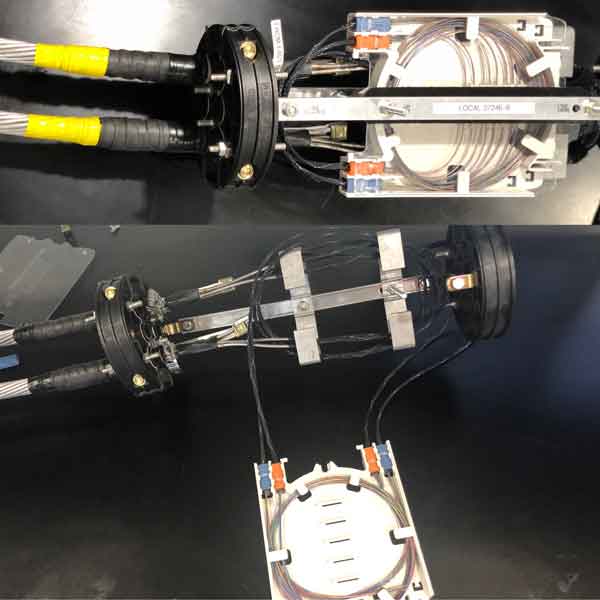
Splice-On
Connector Manufacturers and Tradenames
7/2020
Eric Pearson shared a list he has researched of prepolished
splice connectors with mechanical splices and SOC -
splice-on connectors for fusion splicing. This list shows
how widepread the availability of these connectors has
become, especially the SOCs and low cost fusion splicers.
Mechanical Splice
1. Corning Unicam® (50, 62.5, SM)
1. FIS Cheetah (???)
2. Panduit OptiCam® (50, 62.5, SM)
3. Commscope Quik II (50, 62.5, SM)
4. Cleerline SSF™ (50, SM)
5. LeGrand/Ortronics Infinium® (50, 62.5,
SM)
6. 3M/Corning CrimpLok (50, 62.5, SM)
7. Leviton FastCam© (50, 62.5, SM)
Fusion Splice
2. Inno (50, 62.5, SM)
3. Corning FuseLite® (50, SM)
4. FORC (50, 62.5, SM)
5. Siemon OptiFuse ™ (SM, MM)
6. Belden OptiMax?? FiberExpress (SM, MM)
7. AFL FuseConnect® (SM, MM)
8. OFS optics EZ!Fuse ™ (50, 62.5, SM)
9. Sumitomo Lynx2 Custom Fit® (50, 62.5,
SM)
10. Commscope Quik-Fuse (50, SM)
11. Ilsintech Pro, Swift® (50, 62.5, SM)
12. LeGrand/Ortronics Infinium® (50, 62.5,
SM)
13. Greenlee (50, 62.5, SM)
14. Hubbell Pro (50, SM)
15. Easysplicer (SM)
Note: There are additional manufacturers from the Peoples
Republic of China, which advertise on Amazon and eBay.
|
Worth
Reading
Each
month we read hundreds of newsletters and online articles.
These are the ones we think you will find "worth reading."
|
Worth
Reading: 8/2020
“An
adequate connection is no longer a matter of convenience; it
is a necessity for anyone wishing to participate in civil
society,” wrote the New
York Times Editorial Board in an opinion article published
on Sunday, July 18.
The Institute
for Local Self-Reliance weekly newsletter has lots of
interesting articles and links.
"July has seen the release of complementary reports which
shed light on two of the topics we care about a great deal
around these parts: availability and affordability of
Internet access, and municipally-enabled networks. The Open
Technology Institute at New America just published “The
Cost of Connectivity 2020,” while US Ignite and Altman
Solon issued “Broadband
Models for Unserved and Underserved Communities”
Universal
access to broadband is a cornerstone to a strong economy,
Achieving universal access will require community
partnerships. by Alfreda
B. Norman, Sr. VP, Federal Reserve Bank of Dallas
FIBER
TO THE FARM: The co-ops that electrified
Depression-era farms are now building rural internet. Be
sure to check out the high-tech equine installation
equipment.
CENIC
upgrades California education network to 400G between LA
and Sunnyvale. The new 460-mile route is part of an
overall strategy to upgrade CalREN to 400G. From Lightwave.
Next
Century Cities Newsletter - News from cities around
the US including Detroit and New York plus small towns too.
The NYTimes
On Tech newsletter for August 10 has a great animated
graphic of the Internet connections around the world.

Graphic
by Leon Demise in the NYTimes.
From the July (7/2020) FOA Newsletter, but worth
repeating:
If
the internet was a utility, could more cities provide it?
Marketplace on NPR interviews Katie Espeseth, the vice
president of new products for Chatanooga's EPB. She says
that internet access is a utility.
Infrastructure
Get Some Respect, NY TImes "On Tech" "The magic
of the internet requires a lot of very boring stuff behind
the scenes. "
From the June (6/2020) FOA Newsletter, but worth
repeating:
“For nearly 100 years, cooperatives have been the most
successful model for connecting rural Americans to the
utilities they need to keep their homes, businesses, farms
and schools running,” said Christopher Mitchell, Director of
the Community Broadband Networks initiative at the Institute
for Local Self-Reliance (ILSR).
From Cooperatives
Essential to Bringing High-Quality Fiber Internet Access
to Rural America
Read the ILSR report on coops here:
Cooperatives
Fiberize Rural America: A Trusted Model For The Internet
Era
A few important takeaways:
- More
than 210 cooperatives across the country offer gigabit
Internet access to residents and businesses.
- 82%
of North Dakota and 53% of South Dakota landmass is
served by fiber from cooperatives, and residents enjoy
some of the fastest Internet access speeds in the
nation.
- Since
2017, some states have eased restrictions on cooperative
broadband networks, while others have gone even further
by enacting legislation to facilitate the deployment of
cooperative broadband networks.
- A
series of local stories highlights how broadband has
changed lives by improving access to education,
healthcare, and economic opportunities.
- Cooperatives
have proven that this is a model that works. With
increased support from federal and state governments,
they will continue to connect Americans in rural areas
to economic and educational opportunities otherwise
denied to them.
Read
the full report here.
Look at the ILSR
Newsletter too - it covers rural broadband projects
well.
Worth
Reading - News Summary - Past Links Worth Repeating
Next
Generation PoE (Nexans) The New Power over
Ethernet Standards Deliver More Power, Speed, and
Efficiency
Demystifying
5G (Corning): Do you know 5G’s 3 major
benefits, 8 technical goals that deliver those benefits,
and 4 technology building blocks that meet the technical
goals?
Pentagon
official: FCC decision on 5G threatens GPS, national
security
Internet
Statistics and Facts, 2020: Interesting, easy
to get lost here!
Understanding
The True State Of Connectivity In America - 65% of US
counties receive broadband speeds below industry
reports.
Why
Businesses Need Fiber Connectivity, from
Spectrum CATV. Yes, it's a sales pitch, but they make good
points and it indicates they are serious.
DIRT
Report On Damage To Utilities
Common Ground Alliance (CGA) annual DIRT report provides a
summary and analysis of the events submitted into CGA’s
Damage Information Reporting Tool (DIRT) for the year
2018. The complete report is available for download
here. In addition, there is an interactive
dashboard that allows users to filter the data
more by factors contributing to damages.
Structured
Cabling News - a website and weekly
newsletter about cabling.
The
Internet Master Plan for New York City.
The New York City Internet Master Plan is a
comprehensive framework for the infrastructure and
services that provide connectivity to New York City
residents and businesses. This Master Plan will guide
City actions and public-private partnerships to
transform New Yorkers’ access to this essential
infrastructure for generations to come.
Fiber
Trivia From Corning.
Why
understanding PoE now is crucial for electricians
- To ring in the new decade, IDEAL Networks is urging
today's electricians to master new skills and equipment to
cope with the growing use of PoE in intelligent lighting
applications.
Smart
City Projects: Smart city initiatives are
underway across the country. But they face funding and
technology challenges. Many cities want to upgrade
infrastructure to improve resident experience, safety and to
generate revenue.
The
Future Of Work Is Skills - So Stop Worrying About
Degrees - The
reality is the future of work is about skills, not just
degrees. (FOA Newsletter Feb 2020)
Want
a White-Collar Career Without College Debt? Become an
Apprentice (NYTimes)
Apprenticeships probably began with the first jobs, where
young people work under experienced craftspeople to learn
a trade. In the last century, they became more organized
under labor unions like the International Brotherhood of
Electrical Workers, one of the FOA's oldest and biggest
approved school systems. Today, apprenticeships are
expanding as young people look at viable alternatives to
loading themselves with debt while attending college.
The
job market is hot. So why are half of U.S. grads
missing out?
VIAVI
Books On Fiber Optic Testing (2 volumes) - They're back!
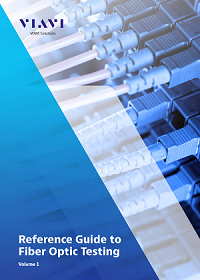
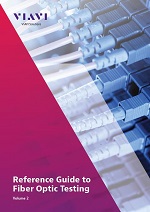
Besides
the FOA reference materials, two JDSU/VIAVI textbooks,
Reference Guide to Fiber Optic Testing, Volumes 1 and
2, were used as references for some of the FOA courses
and are recommended for instructors and students. The books
are available from VIAVI as eBooks and the everyone should
download them and recommend them to others.Download yours
now. Volume
1. Volume
2. Viavi Books
50th
Anniversary of The Development of Low Loss Fibers
A history of the development of low loss fiber, a
fascinating story by Jeff Hecht on the OSA (Optical Society
of America) website.
How
OFS Makes Fiber
Interesting YouTube video on how fiber is made. Perhaps a
little too much "show biz" but fascinating. If you have ever
seen fiber manufacture, look at this video. You will be
amazed at how big preforms have become!
How
Nexans Makes Copper Cables - compare the process
to fiber - don't most of the machines look similar?
The
True Cost of Telco Damages (what backhoe fade or
target practice can cost)
Rural
Electric Cooperatives: Pole Attachment Policies and
Issues, June 2019.
Clearfield-FOA
Certification Training Clearfield is now
offering their customers an FOA
CERTIFICATION course. This course provides
a basic understanding of fiber optic technology, as well
as Clearfield product knowledge and how Clearfield’s
integrated product systems work together in a fiber
network.
Substandard
Contractors - Fiber Optic Knowledge Doesn't Always
Trickle Down (EC Mag)
Another
Source Of Articles On Fiber
FOA
President and editor of this newsletter Jim Hayes has also
been writing a column in Electrical
Contractor Magazine for almost 20 years now.
Electrical contractors do lots of fiber work and this column
has covered some topics they are interested in including
installation processes, network design, fiber applications
and a lengthy series on dark fiber - what it is, how's its
used and how it benefits the growth of communication. A
recent web site redesign makes it easier to browse all these
articles - just go to http://www.ecmag.com/contributing-authors/jim-hayes
and you can see all of them. |
Q&A
Tech
Questions/Comments From FOA Newsletter Readers Worth
Repeating
The
FOA Fiber FAQs
Page (FAQs = frequently asked questions) gathers
up questions readers have asked us (which first ran in
this newsletter) and adds tech topics of general
interest.
|
Good
Question!
The
FOA Fiber FAQs
Page (FAQ s = frequently asked questions) gathers
up questions readers have asked us and adds tech topics
of general interest.
Questions
From FOA Newsletter Readers
August 2020
Mystery Connector From Wind Farm (See above)
FTTH COnnections
Q:
My home is current wired with coax for cable TV. Considering
FIBEROPTICS but do not want any changes/additions to
the internal house wiring. Can an adaptor be installed
external to the house to make the conversion from FIOPTICS
to coax without any need to disturb the current wiring?
A: The adapters used for fiber to the home (FTTH) are
called ONTs - optical network terminals - and they convert
from fiber to coax for TV, two wires for phones and Cat 5 or
WiFi for your computer. You should not need to change the
internal wiring to use FTTH services.
July 2020
Kinking Cables
Q:
i was pulling some MM fiber in pipe today and i had to
go to a different riser a few floors below so i taped the
fiber to a near by pipe to stop it from free falling. When
my coworker a floor below took my remaining slack i went
back to where i tied the fiber to the pipe and i noticed it
was bent sharply going into the pipe but luckily i did not
pull the cable hard once i felt it get tight. I pulled slack
back and inspected the cable but there was no indentation or
sign of a kink. Is this cable completely ruined,should i be
concerned??. Its a multimode corning fiber.
A: The key is if the fibers in the cable test OK.
Corning MM fiber is bend-resisitant fiber and is immune to
most abuse. If it tests OK, you probably don’t need to worry
about it.
Rodents Chewing Cables
Q:
I wonder what you can tell me, or point me to,
regarding rodents and optical cables. I know that rodents go
for electrical cables, even low voltage. von Siemens had to
dig up the first underground distance telegraph cable
because they chewed through the gutta percha. And I know
that their teeth keep growing, and chewing hard stuff, I
guess including wire but not armor, apparently is part of
what they're designed to do. But why fiber?
A: The issue with most cables, fiber or copper, is
the plastic used for the jacket is soft and tastes good to
rodents. The solution is to add armor over the first hacker
and add another jacket to that. Or put the cable inside
ducts. There have been attempts to make the plastic taste
bad that as far as I know failed. In vaults underground,
they put material in the bottom of the vault to prevent
rodent entry.
I remember a great joke in the standards committees in the
80s was a description of the test for rodent penetration -
probably from AT&T who had most standards before EIA/TIA
or ISO. It was something like this - tow cages, one with
standard-sized rodent, other with cable and door between.
Rodent was starved for certain period and then released to
chew cable for fixed period of time to determine cable’s
vulnerability. The joke centered on the “standard rat."
June 2020
Multiplexing
Signals
Q: If a network has 4 10gig lines...how could they or
can these be "bundled" into 40 gig??
A: You multiplex the signals - send one source of
data as a packet in a time slot, then the next 3 in order.
At the other end, you separate them into the original
packets and send diverse ways. Of course, multiplexing the
10G signals into 40G requires speeding up the clock 4 times.
Installation Costs
Q: Do you have any information regarding the cost of
installing the fiber underground?
A: There is no one answer to your question. The cost
of underground construction is a complex function of:
Geography: costs are like salaries, they vary depending on
the locale, NY is much higher than Cordelle, GA for
example), it’s cheaper where the ground is soft dirt vs
rocky, not near wetlands, etc. Urban, suburban and rural
areas are vastly different.
In addition, the cost of all the permits, getting “call
before you dig” assistance and even police details during
construction will be determined by the locale and can vary
widely.
Installation type: trenching and burying conduit or ducts,
trenching and direct burial, microtrenching with microducts
and blowing in cable, directional boring or just pulling
cable into existing ducts.
If the property owner or permit issuer requires “dig once”
where the contractor installs a number of ducts (a very
smart idea), the first installation costs more but later
installs cost much less.
Then there is the cost of the cable, a function of cable
construction, fiber type and number of fibers, number of
splices or drops, etc.
The SOW (scope of work) should call for documentation and
testing. If the SOW requires GIS data and comprehensive
testing - and it should - the cost will reflect that.
So underground installation can cost perhaps as little as
$15-20/ft to as much as $100-200/ft or more. Or as Google
Fiber found in Nashville, underground is not possible when a
town sits on bedrock.
May 2020
Lashing
Aerial Cable With Cable Ties?
Q: I am considering an electrical job installing
fiber optic aerially on a messenger cable.
I have seen the cable tie method of lashing the fiber to the
messenger. Would you recommend this method considering the
cost of a lashing machine for a single project and if so
what would be a good distance between ties for the proper
support of the fiber to the cable.
A: The normal way to attach an aerial cable to a
messenger is lashing the cable with stainless steel wire. If
you use cable ties, you would need ensure the cable doesn’t
droop and the cable ties are designed for outdoor use in the
sun over a long time (stainless steel ones are available).
How long is the span? If it’s more than 100 feet, I think I
would go with lashing. If you don’t have a lasher, you can
rent one. You will need a bucket truck anyway.
Power Budget For PON
Q: Do you have any information on guidelines for
avoiding over saturation in a PON network? Our ONTs have a
power window of between -8dBm and -27dBm. OLT
transceivers transmit at around 4dBm. So our designers
budget for no more than 28dB of loss. However, some ignore
the -8dBm maximum power spec. With a short run from
OLT to ONT and a small splitter, installers are sometimes
seeing light levels at the ONT at around -6 to -7dBm. What
would you recommend as a minimum loss budget in this
case? Do we need margin?
A: The GPON spec does have a max power at the ONT
generally expressed as a minimum loss in the cable plant -
13dB for GPON. There is a graph about halfway down this page
(https://foa.org/tech/ref/appln/datalink.html) that shows a
graph of BER vs Receiver power. To have a link work
properly, it must have sufficient power to be above the
minimum S/N - signal to noise - ratio for the link but not
so much power that it saturates the receiver.
This is a very common situation in telco networks where
links are designed for relatively long distances but may be
used on short ones - e.g. a 40km link being used over 10km
in a city. Their solution is simple - add an attenuator
(https://foa.org/tech/ref/appln/attenuators.html). Lots of
these links use attenuators.
In a PON, there are several ways to go. 1) Brute force -
test each ONT and add attenuators as needed. Techs could
carry a selection of 5dB or 10dB attenuators to get at least
to the 13dB minimum needed. 2) Rather than require testing
at each ONT, have the designer do a loss budget based on the
link length and specify a minimum splitter in the link (8:1
would probably work well) which would probably be cheaper
than testing and adding lots of attenuators.
Midspan
Drop Cables
Q: I
am working on a project that has 5 sections, consisting of 5
miles each section, CCTV, detectors, DMS connected by 192
count fiber. We were directed to use the consultants
plans from the first section as a guide for uniformity for
the remaining contracts. The attached fiber detail
shows a 4 fiber drop cable going to the ITS device. I
was thinking to take all 12 fibers to the device and back
for redundancy? Also, if we did use the 4 fiber drop
cable, I didn’t understand why they would splice the other
10 thru cables and instead leave them intact? Is there a
preferred method for a drop cable to a device or just
preferences?
A: We are not sure why they do it the way they do.
Perhaps the designer was not familiar with midspan access
which would preclude having to make the other splices. Using
a 12 fiber drop cable would be more expensive and perhaps
unnecessary unless the device being connected is in a
location where a small cell site might be located. They may
also have uses for those other fibers that require a
connection through the drop point. We”d suggest to the
designer that midspan access might allow saving the 10
splices at each drop.

The
word on the "Dig Once" program is getting out - FOA is
getting calls from cities asking us for information and
advice. Here are some links:
The DoT page on the administration’s Executive Order: http://www.fhwa.dot.gov/policy/otps/exeorder.cfm
From the Council of State governments: http://www.csg.org/pubs/capitolideas/enews/cs41_1.aspx
From the city of San Francisco: http://sfgov.org/dt/dig-once
An article about Dakota County, MN: https://muninetworks.org/tags/tags/dig-once
And
the one to download and hand out:
A “How To” Guide from The Global Connect Initiative: https://share.america.gov/wp-content/uploads/2016/04/6.-GCI-Dig-Once.pdf
Fiber Optic Cable Plant - The Finished Product 4/2020
In
April, FOA received inquiries from several sources that all
deal with the same subject - what is involved in the
specification and acceptance of a cable plant at the end of
a installation project. And what are reasonable
specifications for a cable plant.
FOA has a lot of documentation on a project involving
designing and installing a cable plant in the
FOA Online Guide and our Textbooks, but the acceptance
process has usually been relegated to a few paragraphs. We
decided to add a page
on project "Deliverables" in the FOA Guide that covers
this topic in more depth. This page looks at a project, goes
into some depth on loss budgets and includes links to FOA
tech documents to help you investigate further.
Correction: In the article, the original list of fiber
specs for G.652 was wrong. It should be 0.4dB/km @ 1310nm.
Deliverables
in the FOA Guide
Is
There A Standard For Fiber Optic Installation?
Another
question we get often is "Is there a standard for fiber
optic installation." The answer is yes, but not from the
usual standards groups you might expect. Over 20 years ago,
the National Electrical Contractors Association (NECA) asked
FOA to help create a standard for installation. That
standard, ANSI/NECA/FOA-301 has been updated three times
already and is about ready for another update.
Unlike most of those groups who charge you a fortune for
standards, FOA covers the cost so ANSI/NECA/FOA-301
is available free from FOA.
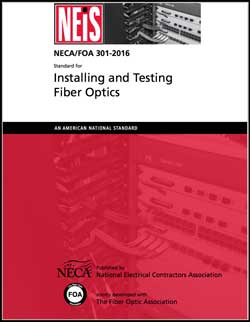
Download
your free copy of ANSI/NECA/FOA-301
here (PDF)
Older
questions are now available here.
|
Training /
FiberU
News and resources to help you learn more and stay
updated.
Find
a listing of all the FOA-Approved schools here.

Free
online self-study programs on many fiber optics
and cabling topics are available at Fiber
U, FOA's online web-based training website.
Free
online training at Fiber U
The
FOA has >100 videos on  |
Welcome
To A New International School
Natech
Training, Tunisia, FOA Approved School #771
Training
Is Back - Made Safer (6/2020)
FOA
schools are starting to offer classes at their facilities
again to provide the personal interaction with an instructor
and hands-on labs, but some things have changed to provide
social distancing. Serge Rodrigue at Fibre
Zone in Quebec, Canada sent photos of his new lab
setup that includes individual lab stations with plexiglass
barriers.
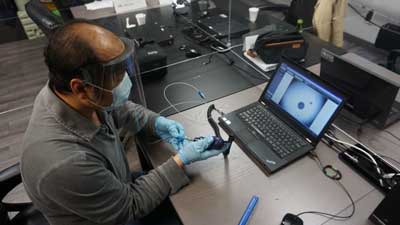
Students are following safe working protocols - masks and
gloves - to make classes safe and meet local government
requirements for social distancing.
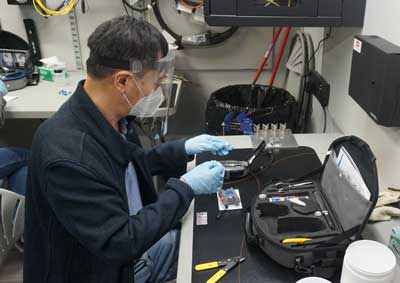
Contact Fibre
Zone in Quebec, Canada for
more information on their classes.
FiberNext in New Hampshire has also rearranged classrooms
for safer classes and has begun training in their facilities
in Concord, NH.
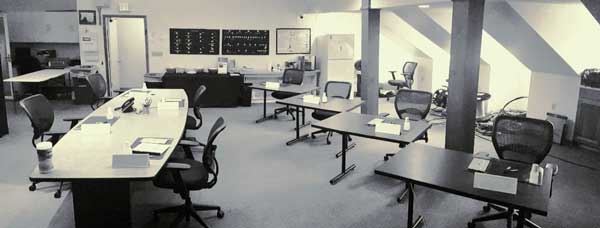
Contact FiberNext
in Concord, NH, USA or
more information on their classes. Also ask about joining
their CFOT
Club for savings on products and training.
Fiber
Optic Training Online - Simulations and Do-It-Yourself
Hands-On Training (6/20)
Simulating
Optical Loss Testing
FOA has been experimenting with simulations,
especially for testing since test equipment is
generally not inexpensive and requires a selection of
cables for reference test cables and cables to test.
We have had an OTDR Simulator based on the software
for an OTDR and a selection of traces for analysis.
Now we've created an optical loss simulator that uses
some web programming to allow stepping through the
process of setting up and testing a cable with a light
source and power meter.
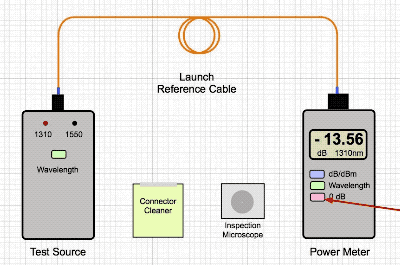
The simulation provides virtual meter and source,
inspection microscope, cleaners and a selection of
cables needed for testing. In the animation above you
can see one of the user interactions - the student
must use the proper button to set the "0dB" reference.
The loss simulator also requires the student use the FOA
Loss Budget Calculator to calculate the expected
loss of a cable under test, compare it to the measured
loss and make a Go/NoGo decision.
We even provide two versions of the simulator -
singlemode and multimode. The singlemode version tests
an OSP cable and then has the student compare OTDR
traces to troubleshoot problems. The multimode version
shows the effects of modal conditioning on multimode
measurements.
At the end, we've even added a wrap-up of the
techniques of loss testing and a quiz.
We added the loss simulator in the new Fiber
U DIY Basic Skills Lab for a virtual hands-on
testing lab.
Check out the FOA
Insertion Loss Simulator here.
DIY (Do-It-Yourself) Labs (6/20)
Knowledge
is easy to get online, but learning skills requires
"hands-on" practice and that requires tools and
components to practice with. Here at FOA, we've been
working on an online course that could help many
techs learn new skills or improve others using an
online self-study course and their own equipment. Recently,
we have updated the materials in the Fiber
U Fiber Optics Basic
Skills Labs which includes cable
preparation, splicing, termination and testing.
And we have created a Basic
Skills Labs - Copper Premises Cabling to
cover UTP (Cat 5) and coax copper cable
processes. As with all Fiber U courses, these
are free.
Several times in the FOA Newsletter we've discussed
the Fiber
U Basic Skills Lab. This online DIY lab course
assumes you have your own equipment to use for the
labs, but most novices, unless they work for a larger
company already in fiber optics, will not have
equipment. FOA instructors have found a solution:
purchase inexpensive equipment online. What they have
found are many low cost tools and components that are
perfectly suited to training.
If
you do not have tools or equipment and want to
purchase them, there is a new
Fiber U DIY Basic Skills Lab lesson with
directions on how to purchase inexpensive tools
online and use them to learn basic fiber optic
skills. Those tools and components are what we
describe here.
For example, you need a fiber cleaver
for splices and prepolished/splice connectors. A good
cleave is essential for a good splice or termination
with a splice-type connection. Good cleavers are now
available online at prices in the US starting at
$20US.
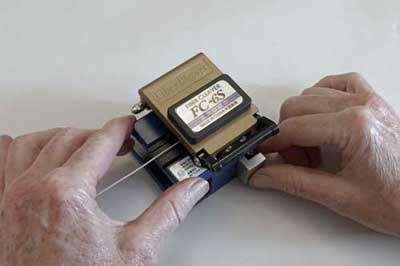
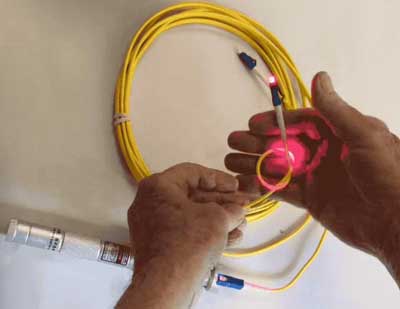
Besides the cleaver, another really good tool for
learning or teaching is a visual fault locator. These
devices used to be very expensive, but now are
available online for $10-20.
Many online sellers offer sets of fiber optic tools in
a kit for very low cost.
With plenty of tools available online, the next things
you need are components to practice on. No problem
here either. You need a patchcord, some mechanical
splices and some prepolished/splice connectors. The
connectors and splices are available from online
sellers for ~$1 each, easy to afford plenty to
practice on.
FOA has used all these available parts together into a
do-it-yourself
hands-on lab as part of the Fiber U Basic Skills
Lab. You can do this yourself at a very low
cost. We
even provide directions on how to search for
suppliers of these tools and components.
Caution!
FOA has not exhaustively tested these tools or
components enough to recommend them for field use. The
work we did with them to create teaching labs shows
they are certainly good enough to use for teaching the
installation processes in a training lab. We suggest
read the buyers reviews and do some of your own
testing before using them for anything other than
training and practice.
FOA
Guide "Basics Of Fiber Optics" Now Available in Portuguese
(6/2020)

FOA has
now translated the Basics of Fiber Optics textbook in our
Online Guide into Portuguese, joining Spanish and French
translations. For those speaking Portuguese, we have the
technical information and for schools we also have
curriculum available.
Here
is the FOA
Guide in Portuguese,
Spanish and
French
translations.
Time
To Learn - Online - (Update 4/5/6/8 2020)
Schools
have generally been closed during the pandemic lock-downs,
so FOA has been working with some of them to create new
online learning experiences that can in some cases lead to
certification online. FOA certifications are still based on
the KSAs - knowledge from the classroom, skills from the
labs and abilities judged by instructors or proven by actual
experience.
ZOOMing
Much of what we're doing benefits from the capabilities of
"Zoom." Others have created videoconferencing apps, but none
work so well, especially with limited bandwidth. We've seen
remote labs that have an instructor showing students how to
use the tools they were sent then watching them duplicate
their actions. We have worked out methods to use Zoom to
proctor FOA's online certification exams.
Blended
Learning
While most FOA schools have suspended in-person training
during this period, some are offering a "blended
learning" option. That means that students sign up for a
FOA certification course, take the classroom sessions on
Fiber U with the assistance of a FOA certified
instructor. Now online instruction can include reviewing
the labs using the Fiber
U Basic Skills Labs, then when it's possible to attend
classes at the school, complete the hands-on labs and
take the FOA certification exam.
Online Remote Labs
Alternatively, some schools are experimenting with
"remote labs," where the students get sent tool kits
and components and labs are conducted by
videoconferencing. Before the labs, the students may
watch demos by their instructor on videoconferencing
and/or review the relevant "virtual hands-on" lessons
in the Fiber U Fiber
Optics Basic
Skills Labs so they will already know
the steps in the exercises. And
Fiber U has the new
Fiber U DIY Basic Skills Lab lesson
with directions on how to purchase
inexpensive tools online and use them
to learn basic fiber optic skills. Videoconferencing
allows the instructor to remotely monitor their
work and provide help as needed. Contact
the FOA for more information.
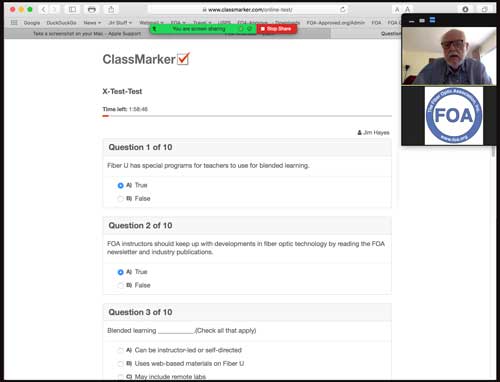
FOA Zoom Exam Proctoring
Online
Certification Testing
FOA has all its certification tests available
online, both for use by our schools and by our
direct "Work
to Cert" applicants. All FOA certification
tests require a proctor to oversee the applicant
taking the exam. In this time of social
distancing, getting a proctor can be difficult, so
FOA now has procedures for online proctors
administering the exam. Contact
the FOA for more information.
OJT - On-The-Job-Training
Many novices get a job and learn on the job. They
usually have an experienced tech who helps them gain the
knowledge and learn the skills they need to
perform their job. Thinking about this in relation to
the
FOA KSAs, the knowledge, skills and
abilities needed by a fiber optic tech, the tech
will learn skills but not the basic knowledge that helps
them understand the processes involved. FOA can offer
help here, using our Fiber
U online self-study programs. While the tech
learns on the job, they become a Fiber
U trainee, getting the knowledge they need,
while working under their "mentor" at work. This is
particularly good for contracting companies who need
techs but do not have the usual training courses
available. Interested in OJT programs? Contact FOA
for more information.
Can
You Learn Hands-On Skills Online?

Knowledge is easy to learn online, but learning skills
requires "hands-on" practice and that requires tools and
components to practice with. Here at FOA, we've been working
on an online course that could help many techs learn new
skills or improve others using an online self-study course
and their own equipment. Recently,
we have updated the materials in the Fiber
U Fiber Optics Basic
Skills Labs which includes cable preparation,
splicing, termination and testing. And we have created a
Basic
Skills Labs - Copper Premises Cabling to cover
UTP (Cat 5) and coax copper cable processes. As with
all Fiber U courses, these are free.

FOA offers free online self-study programs at Fiber
U. Many users are preparing for FOA certification
programs - taking courses at our schools or using the "Work-to-Cert"
program. Some of our schools are requiring Fiber U programs
as prerequisites for their classroom courses so they can
spend more time on hands-on activities.
New
FOA Approved School: Central
Electrical Training Center, FOA
School #656.
Find
a listing of all the FOA-Approved schools here.
FOA
School Offers Toolkit With Online Training
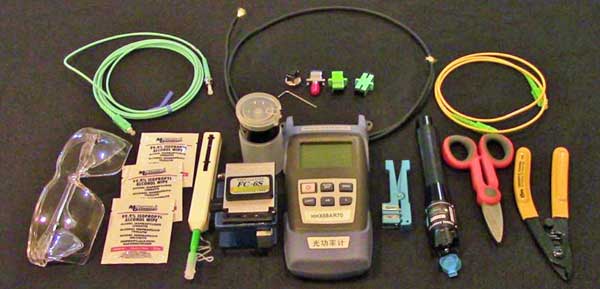
Slayton
Solutions (FOA Approved School #156) is offering a simple
fiber optic tool kit that includes a 29-piece set of fiber
optic tools and a power meter along with training videos
and online instruction for only $499. 29 Piece Kit
includes all tools and devices a technician needs to
install fiber optic connectors and test optical
power. Information
on the kit is available on YouTube.
You can contact them for more information at
slaytonsolutions@sbcglobal.net
or https://www.fiberopticsinstitute.com
|
Publications /
Resources

|
FOA
Loss Budget Calculator On A Web Page 5/2020
FOA has
written many articles about loss budgets, something everyone
involved in fiber optics needs to know and needs to know how
to calculate. We recently discovered how to get a
spreadsheet ported to a Web page, so we created this web
page that calculates loss budgets. We have an iOS loss
budget app, but with this web page, you can calculate loss
budgets from any device, smart phone, tablet, laptop, or
desktop computer that has web browsing capability.

Bookmark this page (especially on your smartphone): FOA
Loss Budget Calculator Online
 We are
continually updating the Online Reference Guide to keep up
with changes in the industry and adding lots of new pages of
technical information. When you go to the FOA
Guide Table of Contents to see the latest updates -
look for
We are
continually updating the Online Reference Guide to keep up
with changes in the industry and adding lots of new pages of
technical information. When you go to the FOA
Guide Table of Contents to see the latest updates -
look for  . .
Recent updates:
10GPON
on PON Protocols in the FOA Guide.
Coherent
Communications Systems in the FOA Guide.
Updated
(and more illustrations): Basic
Fiber Optic Jargon, OSP
Fiber
Optic Jargon and Fiber
Optic Jargon for managers.
Fiber
Optic Network Restoration
Fiber
Characterization goes in to more depth, why fiber
characterization is important and how to interpret results.
Fiber
Optic Network Management for managers
FOA
has created a section on OSP
Construction and a Fiber
U course based on it.
FOA
Guide section on inspecting and cleaning connectors.
Go
to The
FOA Online Fiber Optic Reference Guide.
FOA Reference Books
Available Printed or Kindle Books
The
fiber book is available in Spanish and French (printed) and
Portuguese (online). The design book is available in Spanish
(online)








FOA has
reprinted "Lennie
Lightwave's Guide" on its 25th anniversary in
a special print edition.
Lennie
and Uncle
Ted's Guides are online or as free iBooks on iTunes.


Click
on any of the books to learn more.
- Fiber
Optic Safety Poster to download and print
Resources
For Teachers In K-12 And Technical Schools
Teachers in all grades can introduce their students to
fiber optic technology with some simple demonstrations.
FOA has created a page for STEM or STEAM (science,
technology, engineering, arts
and math) teachers with materials appropriate to their
classes. Fiber
Optic Resources For Teachers.
|
Safety
|
On
Safety
FOA
considers safety an integral part of all our programs,
curriculum materials and technical materials. We start all
our textbooks and their online versions with a section on
safety in the first chapter, like this: Before
we get started - Safety First!
There are pages on the FOA Guide on Safety
procedures Including Eye Safety and. Digging
Safely
And a YouTube lecture: FOA
Lecture 2: Safety When Working With Fiber Optics
In our OSP Construction Section, these pages cover many
safety issues including those related to the construction of
the cable plant: Project
Preparation And Guidelines, Underground
Cable Construction, Underground
Cable Installation and Aerial
Cable Installation.
There is even a safety poster for the fiber activities: PDF
Safety Rules For Fiber Optics
The FOA is concerned about safety!
There
is a toll-free "call before you dig" number in the USA:
Dial 811
See
www.call811.com for
more information
The
Common Ground Alliance has an excellent "Best
Practices Guide" online
- The
US Department of Transportation has a website called "National
Pipeline Mapping System" that allows one to
search for buried pipelines.
Why
We Warn You To Be Careful About Fiber Shards
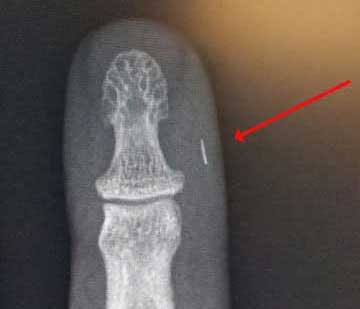
Photo courtesy Brian Brandstetter, Mississauga
Training Consultantcy
Safety
Leader Magazine
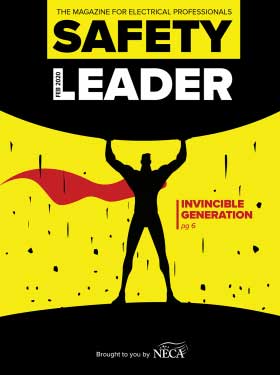
Safety Leader, a new quarterly magazine, informs and
educates electrical contractors on safety from various
angles—electrical, workplace, PPE, regulations, leadership,
line work, NFPA 70E, and more. Safety Leader is bundled with
ELECTRICAL CONTRACTOR in February, May, August and November.
To receive Safety Leader subscribe
to ELECTRICAL CONTRACTOR magazine here or subscribe
to the ELECTRICAL CONTRACTOR newsletter here.
2020
Conference On Damage Prevention Cancelled But Goes Online
You can
watch FOA's presentation "New
Construction Techniques In Fiber Optics" on YouTube.
Next
Conference On Damage Prevention Scheduled for 2021
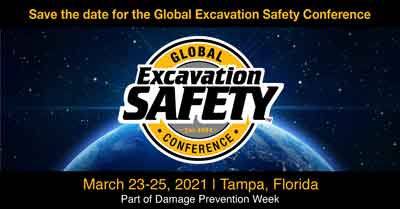
Global
Excavation Safety Conference & Expo, the
premiere international event in the damage prevention
industry, was supposed to be March 24-26 but was
cancelled due to the pandemic. 2021's program will be in
Tampa.
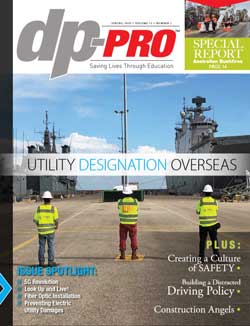
The magazine, dp-Pro, sponsor of the conference, has
also published it's latest issue with an article by FOA
on "New Construction Techniques in Fiber Optics" and a
overview of the FOA. You
can read the magazine here.
Best
Practices Guide For Underground Construction
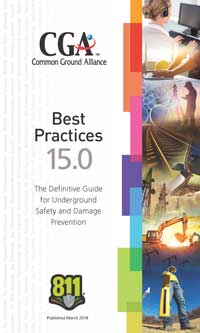
We
assume you are familiar with the "One Call" and "Call
Before You Dig" (811) program, but are you also
familiar "Click
Before You Dig.com" and with the people behind
it - the Common Ground Alliance and their Best Practices
website?
Officially
formed in 2000, the CGA represents a continuation of the
damage prevention efforts embodied by the Common
Ground Study.
Sponsored by the U.S. Department of Transportation and
completed in 1999, this Study represents the collaborative
work of 160 industry professionals who identified best
practices relating to damage prevention. Any
best practice or program endorsed by the CGA comes with
consensus support from experts representing the
following stakeholder groups: Excavators, Locators, Road
Builders, Electric, Telecommunications, Oil, Gas
Distribution, Gas Transmission, Railroad, One Call,
Public Works, Equipment Manufacturing, State Regulators,
Insurance, Emergency Services and Engineering/Design.
Read
the CGA Best Practices Guide here.
Here
are all the CGA resources for damage prevention.
The
US Department of Transportation has a website called "National
Pipeline Mapping System" that allows one to search
for buried pipelines. |
FOA/About
About
The FOA
- Contact
Us: http://www.foa.org
or email <info@foa.org>

FOA
has a company page and four LinkedIn Groups
FOA
- official company page on LinkedIn
FOA
- covers FOA, technology and jobs in the fiber optic
marketplace
FOA
Fiber Optic Training - open to all, covers fiber optic
technology and training topics
Grupo
de La Asociación de Fibra Óptica FOA (Español)
|
What is The FOA?
The FOA is a, international non-profit educational
association chartered to promote professionalism in fiber
optics through education, certification and standards.
Founded in 1995 by a dozen prominent fiber optics trainers
and leaders from education, industry
and government as
a professional society for fiber optics and a source of
independent certification, the FOA has grown to now being
involved in numerous activities to educate the world about
fiber optics and certify the workers who design, build and
operate the world's fiber optic networks.
FOA
is 25 years old this July - read about FOA's history in
this newsletter above.
Learn
More About FOA's History.
Contact
Us
The Fiber Optic Association Inc.
http://www.foa.org or email
<info@foa.org>
The
FOA Home Page

Want
to know more about fiber optics? Study
for FOA certifications? Free
Self-Study Programs are on "Fiber
U®." Looking for specific information? Here's the
largest technical reference on the web: The
FOA Online Fiber Optic Reference Guide.

Free
online self-study programs on many fiber optics and cabling
topics are available at Fiber
U, FOA's online web-based training website.
|
-
Contact
Us
The Fiber Optic Association Inc.
http://www.foa.org or email
<info@foa.org>
The
FOA Home Page
(C)1999-2020,
The Fiber Optic Association, Inc.
|
FOA
Logo Merchandise
New
FOA Swag! Shirts, Caps, Stickers, Cups, etc.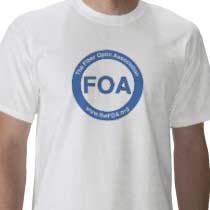
The FOA
has created a store on Zazzle.com offering lots of new logo
merchandise. It has lots of versions of shirts and other
merchandise with "FOA," "Fiber U," "Lennie Lightwave"
designs and more so you should find something just for you!
See FOA
on Zazzle.
-
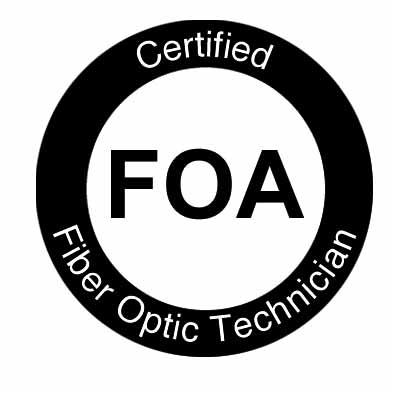
Your
Name, CFOT® - It pays to advertise!
The
FOA encourages CFOTs to use the logo on their business
cards, letterhead, truck or van, etc. and provides logo
files for that purpose. But we are also asked about how to
use the CFOT or CFOS certifications. Easy, you can refer
to yourself as "Your Name, CFOT" or "Your Name, CFOS/T"
for example.
Feel
free to use the logo and designations to promote your
achievements and professionalism!
Contact
FOA at info@thefoa.org to get logos in file format for your
use.
Privacy
Policy (for the EU
GDPR): The FOA does not use cookies or any other
web tricks to gather information on visitors to our
website, nor do we allow commercial advertising. Our
website hosts may gather traffic statistics for the
visitors to our website and our online testing service,
ClassMarker, maintains statistics of test results. We do
not release or misuse any information on any of our
members except we will confirm FOA certifications and
Fiber U certificates of completion when requested by
appropriate persons such as employers or personnel
services.
Read
the complete FOA Privacy Policy here.
|




































































 .
.





